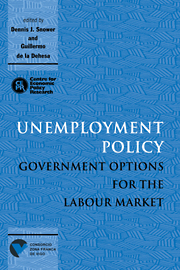Book contents
- Frontmatter
- Contents
- List of figures
- List of tables
- Preface
- Acknowledgements
- List of conference participants
- 1 Introduction
- PART ONE GENERAL POLICY ISSUES
- PART TWO DEMAND MANAGEMENT AND SUPPLY-SIDE POLICY
- PART THREE SUBSIDISING EMPLOYMENT AND TRAINING
- 6 The simple economics of benefit transfers
- Discussion
- Discussion
- 7 Wage subsidy programmes: alternative designs
- Discussion
- Discussion
- 8 Technological development, competition from low-wage economies and low-skilled unemployment
- Discussion
- 9 Macroeconomic and policy implications of shifts in the relative demand for skills
- Discussion
- 10 Would cutting payroll taxes on the unskilled have a significant impact on unemployment?
- Discussion
- 11 Preventing long-term unemployment: an economic analysis
- Discussion
- Discussion
- PART FOUR LABOUR MARKET REGULATIONS
- PART FIVE POLICY, JOB REALLOCATION AND THE UNEMPLOYMENT–PRODUCTIVITY RELATION
- PART SIX COMPARING UNEMPLOYMENT POLICIES
- Index
Discussion
Published online by Cambridge University Press: 07 September 2010
- Frontmatter
- Contents
- List of figures
- List of tables
- Preface
- Acknowledgements
- List of conference participants
- 1 Introduction
- PART ONE GENERAL POLICY ISSUES
- PART TWO DEMAND MANAGEMENT AND SUPPLY-SIDE POLICY
- PART THREE SUBSIDISING EMPLOYMENT AND TRAINING
- 6 The simple economics of benefit transfers
- Discussion
- Discussion
- 7 Wage subsidy programmes: alternative designs
- Discussion
- Discussion
- 8 Technological development, competition from low-wage economies and low-skilled unemployment
- Discussion
- 9 Macroeconomic and policy implications of shifts in the relative demand for skills
- Discussion
- 10 Would cutting payroll taxes on the unskilled have a significant impact on unemployment?
- Discussion
- 11 Preventing long-term unemployment: an economic analysis
- Discussion
- Discussion
- PART FOUR LABOUR MARKET REGULATIONS
- PART FIVE POLICY, JOB REALLOCATION AND THE UNEMPLOYMENT–PRODUCTIVITY RELATION
- PART SIX COMPARING UNEMPLOYMENT POLICIES
- Index
Summary
Nickell and Bell's chapter 10 provides valuable insights on a theme that keeps recurring in economic debates in the world at large: ‘can a shift in the relative demand for labour in favour of skilled workers and against unskilled workers explain an increase in the aggregate rate of unemployment?’ As Krugman (1994) and others have previously argued, the answer is clearly ‘yes’ if a wage floor (e.g. minimum wage) prevents the wage rate for unskilled workers from dropping, leading to extra unskilled unemployment that becomes part of aggregate unemployment. The difficulties, as we shall see below, are in finding the quantitative counterpart of the relative demand shift in microeconomic data, and in attributing to that demand shift more than a small part of the overall rise in unemployment that has plagued Europe since the early 1980s.
The title of chapter 10 proclaims that it is about payroll taxes, but it is not, at least after the first page. Any link between the payroll tax and unemployment is dismissed by ‘a glance at Denmark’ and by figure 10.1, which shows no significant relationship between unit labour costs and payroll tax rates. But figure 10.1 is not convincing, because there are many causes of the cross-country variation in unit labour costs displayed there. A role for the payroll tax that is not evident in the simple bivariate regression reported by the authors might emerge in a full-blown multiple regression study.
- Type
- Chapter
- Information
- Unemployment PolicyGovernment Options for the Labour Market, pp. 329 - 332Publisher: Cambridge University PressPrint publication year: 1997
- 1
- Cited by



